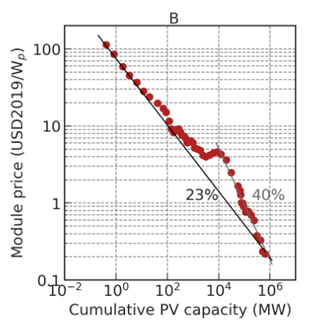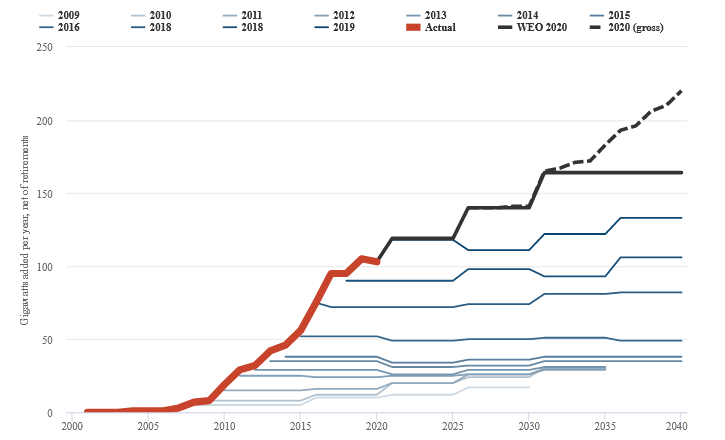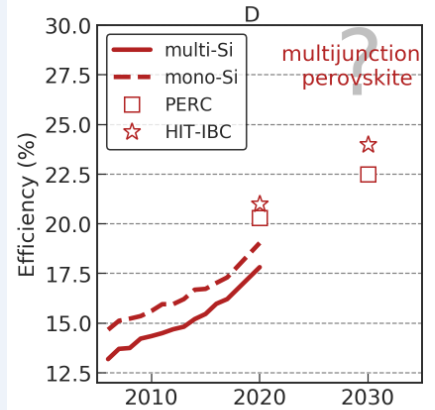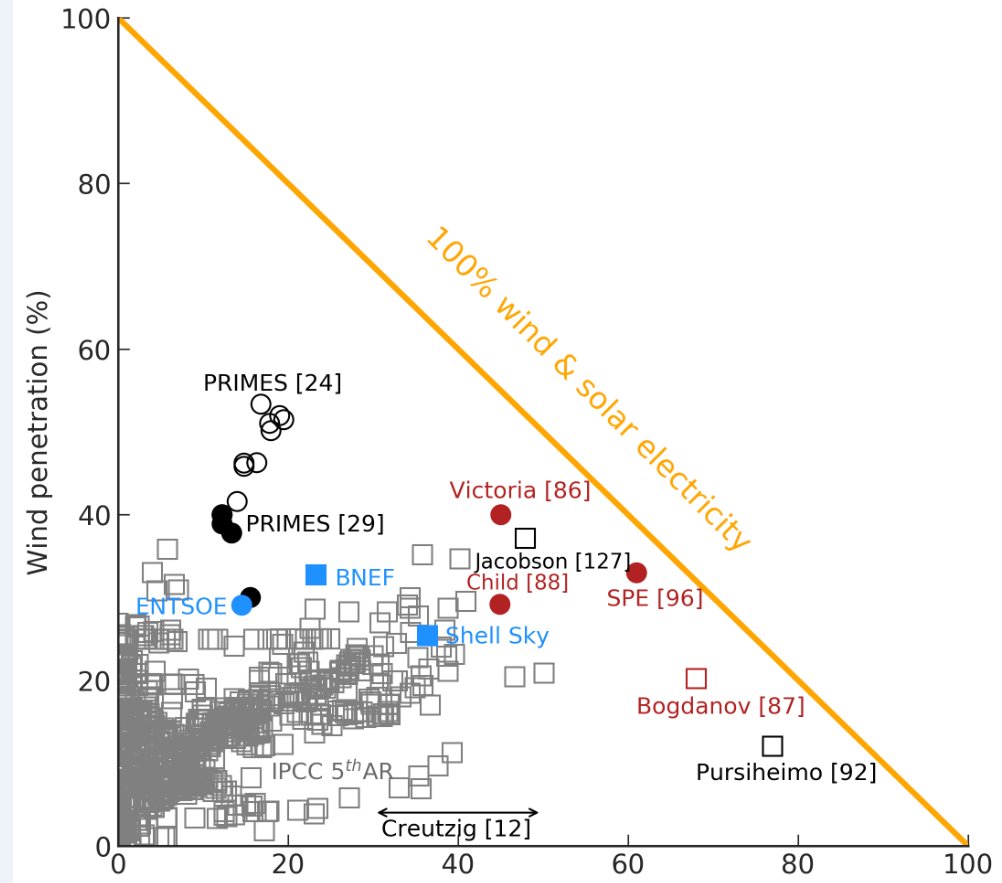
We have just published a perspective in @Joule_CP. Main message: Although underestimated by many models, solar PV has a large potential for mitigating climate change in the next decade which is key to remain on a path compatible with the Paris Agreement. authors.elsevier.com/a/1cpj3925JEG7…
As stated in the summary, our aim is to open a constructive discussion among PV experts, modellers, and policymakers regarding how to improve the representation of this technology in the models, and how to ensure that manufacturing and installation of solar PV can ramp up on time
Summary threat (a long one, so you may select what you are interested in)
Tweets 1-7: how solar become so cheap so fast
Tweets 8-9: innovations in the pipeline
Tweets 10-20: why some models have underestimated the potential of PV
Tweets 21-29: challenges for a fast ramping up
Tweets 1-7: how solar become so cheap so fast
Tweets 8-9: innovations in the pipeline
Tweets 10-20: why some models have underestimated the potential of PV
Tweets 21-29: challenges for a fast ramping up
(1/n) PV costs have reduced dramatically with a 23% learning rate (costs reduced by 23% every time the installed capacity doubles) thanks to technical improvements (efficiency gains, larger and thinner wafers, diamond wire sawing, etc.) and … 

(2/n) … high-level mechanisms: learning by doing, R&D and economies of scales. @GregNemet and G. Kavlak provide detailed explanations of these mechanisms. Some recent presentations
https://twitter.com/JesseJenkins/status/1360282723265486849
https://twitter.com/mitenergy/status/1245764407331893249
(3/n) All the previous mechanisms were catalysed by policies that stimulated market growth through feed-in tariff or renewable portfolio standard.
THIS is what we should try to replicate!
The BIG question is: Can we use policy to make the necessary technologies cheap on time?
THIS is what we should try to replicate!
The BIG question is: Can we use policy to make the necessary technologies cheap on time?
(4/n) The fact that PV is modular or granular (i.e. small unit size and low unit investment) has played a role in enabling such fast learning as discussed here: science.sciencemag.org/content/368/64…
(5/n) Learning has even accelerated in recent years (40% LR) due to standardization of the material supply chain, manufacturing tools made in China with higher throughputs and lower costs. Pierre Verlinden, Yifeng Chen, and @solar_chase know a lot about what has happened recently 

(6/n) On top of module costs, there are other aspects where learning is key such as the finance of the power plants, the WACC, or the Operation & Maintenance costs @BjarneSteffen @floegli @EAVgooner
onlinelibrary.wiley.com/doi/full/10.10…
sciencedirect.com/science/articl…
onlinelibrary.wiley.com/doi/full/10.10…
https://twitter.com/NatureEnergyJnl/status/1182682158168793090
sciencedirect.com/science/articl…
(7/n) PV is so cheap now that even the @IEA finally had to predict significant deployment in the coming decades (after years of underestimating the future as @AukeHoekstra has been showing us)
carbonbrief.org/solar-is-now-c…
https://twitter.com/aukehoekstra/status/931869221386104832
carbonbrief.org/solar-is-now-c…

(8/n) Will this learning saturate at some point? Probably, but in our perspective, we also highlight innovations in the pipeline. New cells technologies: bifacial, silicon heterojunction (HIT), interdigitated back contacts (IBC), multijunction solar cells, perovskite/c-Si tandem 

(9/n) + Industrial innovations: larger cells and modules, half-cells, multi-wire, etc.
+ Innovations at the plant level: 1-axis tracking, higher DC/AC ratio to increase the utilization of the inverter and the grid connection capacity, etc.
+ Innovations at the plant level: 1-axis tracking, higher DC/AC ratio to increase the utilization of the inverter and the grid connection capacity, etc.
(10/n) Despite the promising performance of the technology, the contribution of solar PV to low-emissions scenarios has been traditionally underestimated by IAMs and partial equilibrium models. 

(11/n) In a recent paper, @etrutnevyte and Marc Jaxa-Rozen reached a similar conclusion. They say in their abstract:
“IPCC scenarios consistently project lower PV adoption pathways and higher capital costs than non-IPCC scenarios”
“IPCC scenarios consistently project lower PV adoption pathways and higher capital costs than non-IPCC scenarios”
https://twitter.com/etrutnevyte/status/1367170178509918216
(12/n) Why is that? Mainly 3 reasons: 1⃣ outdated cost assumptions. In the IAM models compared by Krey and co-authors, most of them assume system cost in 2050 higher than the average (minimum) cost today: 0.995(0.618) €/W according to @IRENA sciencedirect.com/science/articl… 

(13/n) This issue was also highlighted by @etrutnevyte and Marc Jaxa-Rozen and is a usual #hotopic on Twitter.
https://twitter.com/etrutnevyte/status/1367178061553238019
(14/n) 2⃣ models which don't include hourly resolution, either include integration costs or limit the wind+solar penetration in the grid. If the formers are too high or the latter too stringent, solar is over-constrained
(15/n) E.g. check the wind/solar penetration in the models included in the @IPCC_CH 5th AR compared with scenarios created by energy models including uninterrupted hourly resolution + low-cost assumption + possibilities for (direct or indirect) electrification of other sectors. 

(16/n) The model ensemble in the @IPCC_CH 1.5ºC Special Report #SR15 includes scenarios with higher solar penetration, but this might not be enough because there is an additional problem (3⃣)
(17/n) If electrification of other sectors is not fully available in the model (either directly or indirectly via electro-fuels). The full potential of solar/wind cannot be exploited, and future scenarios include very small contributions of those technologies to primary energy. 



(18/n) The impact of using up-to-date cost in AIMs was already highlighted by @efesce et al. using REMIND model, they found that solar PV covers 30%–50% of global electricity demand in 2050 (compared with 5%–17% share in previous results). nature.com/articles/nener…
(19/n) The underestimation of solar PV is also present in the PRIMES analyses supporting the Clean Planet for All strategy by the @EU_Commission @EUClimateAction
ec.europa.eu/clima/sites/de…
knowledge4policy.ec.europa.eu/publication/co…
ec.europa.eu/clima/sites/de…
knowledge4policy.ec.europa.eu/publication/co…

(20/n) We acknowledge that some IAMs are trying to improve (by updating the costs, increasing time resolution, and coupling with power system models). Looking forward to seeing if scenarios with high wind and solar penetrations are included in the ensemble of the @IPCC_CH 6th AR!
(21/n) In this perspective, we also discuss the challenges for high solar PV penetration at different time scales and the existing strategies. Summary table below, more details in the paper 

The thread continues here:
https://twitter.com/martavictoria_p/status/1376813625051070464
• • •
Missing some Tweet in this thread? You can try to
force a refresh



